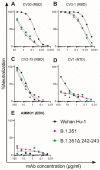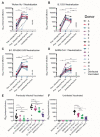This is a preprint.
A single mRNA immunization boosts cross-variant neutralizing antibodies elicited by SARS-CoV-2 infection
- PMID: 33758873
- PMCID: PMC7987032
- DOI: 10.1101/2021.02.05.21251182
A single mRNA immunization boosts cross-variant neutralizing antibodies elicited by SARS-CoV-2 infection
Update in
-
mRNA vaccination boosts cross-variant neutralizing antibodies elicited by SARS-CoV-2 infection.Science. 2021 Mar 25;372(6549):1413-8. doi: 10.1126/science.abg9175. Online ahead of print. Science. 2021. PMID: 33766944 Free PMC article.
Abstract
Emerging SARS-CoV-2 variants have raised concerns about resistance to neutralizing antibodies elicited by previous infection or vaccination. We examined whether sera from recovered and naive donors collected prior to, and following immunizations with existing mRNA vaccines, could neutralize the Wuhan-Hu-1 and B.1.351 variants. Pre-vaccination sera from recovered donors neutralized Wuhan-Hu-1 and sporadically neutralized B.1.351, but a single immunization boosted neutralizing titers against all variants and SARS-CoV-1 by up to 1000-fold. Neutralization was due to antibodies targeting the receptor binding domain and was not boosted by a second immunization. Immunization of naïve donors also elicited cross-neutralizing responses, but at lower titers. Our study highlights the importance of vaccinating both uninfected and previously infected persons to elicit cross-variant neutralizing antibodies.
Figures




References
Publication types
Grants and funding
LinkOut - more resources
Full Text Sources
Other Literature Sources
Miscellaneous
